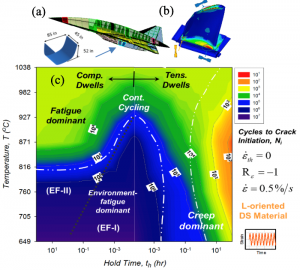Mentor: Ali P. Gordon
Description: Advanced materials used for hot components (e.g., hypersonic fuselage panels, turbine blades) are often subjected to both (1) low rate, high amplitude mechanical loading due to conventional cycling and (2) high rate, low amplitude stresses due to vibration. Although materials with anisotropic microstructures confer superior strength against creep-fatigue up to 850°C, materials may display a number of failure mechanisms depending on the specific loading scenario. Directionally-cast and additively-manufactured materials are increasingly employed in conditions where thermal and mechanical cycling facilitate cyclic plasticity and creep. Life prediction methods at high temperatures have yet to progress to the point in which thermo-acousto-mechanical loading can be predicted with reasonable accuracy. Materials for hypersonic flight applications will be subjected to thermo-elastic buckling with super-imposed acoustic loading in an existing mechanical testing platform to support the development of constitutive models for deformation and lifing methods for crack nucleation and early propagation. Both graduate and undergraduate students will be exposed to experimental, theoretical, and computational mechanics as a part of this module; optimization and analysis of variance methods may be included per student interest.
The faculty mentor and the graduate student will train the REU student. The REU student will then conduct mechanical testing and simulate test data with constitutive models (via ANSYS). The student will learn to fabricate test coupons and design test scripts along with analytically manipulating stress-strain formulae. The research skills gained in this research are designed to be useful for future Ph.D. studies. Undergraduate students will be encouraged to contribute to various research communications (e.g. lab tours and articles for archival journals).

Hot structures: (a) hypersonic platform fuselage panel, (b) FEA model of turbine blade, and (c) creep-fatigue damage mechanism map for life prediction.